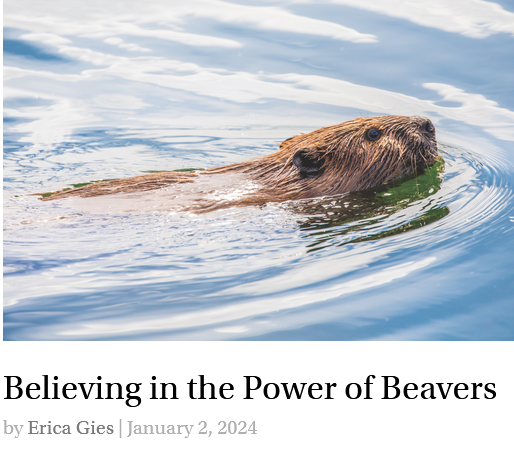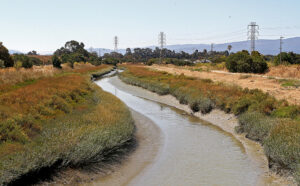More lovely reporting on the big beaver decision out of the UK this month, this time for all too see in the Guardian!
A valley in the Forest of Dean will echo to the sound of herbivorous munching next spring when a family of beavers are released into a fenced enclosure to stop a village from flooding, in the first ever such scheme funded by the government.
 Chris McFarling, a cabinet member of Forest of Dean district council, said: “Beavers are the most natural water engineers we could ask for. They’re inexpensive, environmentally friendly and contribute to sustainable water and flood management.
Chris McFarling, a cabinet member of Forest of Dean district council, said: “Beavers are the most natural water engineers we could ask for. They’re inexpensive, environmentally friendly and contribute to sustainable water and flood management.
“They slow the release of storm water with their semi-porous dams, decreasing the flooding potential downstream. Water quality is improved as a result of their activities. They also allow water to flow during drought conditions. Financially they are so much more cost-effective than traditional flood defence works so it makes sense to use this great value-for-money opportunity.”
The plan for the village of Lydbrook, Gloucestershire, may soon be joined by other schemes. The environment secretary, Michael Gove, has indicated that the government may support other schemes to restore the beaver four centuries after it was driven to extinction in England and Wales.
Well, how about that for re-branding! Instead of whining that beavers can cause flooding get an entire country to broadcast that they actually can prevent flooding. And some great data to back up that claim. We are all thrilled to see the excitement accompanying this new release. The value of beavers is being shouted from the the rooftops and you know that always makes me happy.
The Forestry Commission will monitor the impact on wildlife – shown to be hugely beneficial – as well as recording the water flow in the brook. “The beaver has a special place in English heritage and the Forest of Dean proposal is a fantastic opportunity to help bring this iconic species back to the countryside,” said Gove. “The community of Lydbrook has shown tremendous support for this proposal and the beavers are widely believed to be a welcome addition to local wildlife.”
Ahhh that’s so wonderful. I’m almost jealous thinking what it would be like to start here, with the science behind you, the papers and public support, and almost everyone on your side. Can you imagine what a wonderful beaver festival they could pull off? Folks all over the country could come, there could be deals with the local B&B’s. With tours that teach proper beaver watching – maybe you could earn a badge that says your a qualified beaver observer – and everywhere wildlife education, music, beaver games. Maybe include local crafts, beer and sausage rolls? Jon would be in heaven.
Closer to home, our own beaver research has changed at least ONE mind in the Sierras. Thanks to Sherry Guzzi who sent this article yesterday that I somehow missed. The article mostly talks about how beavers make their way in the winter, but as you can see,it starts by covering the sierra nativity of everyone’s favorite topic.
 The beaver has long been thought to be non-native to the Sierra, but new evidence proves otherwise. As winter approaches, we will be working right alongside this “native” resident as it too gets ready for the cold, hard season.
The beaver has long been thought to be non-native to the Sierra, but new evidence proves otherwise. As winter approaches, we will be working right alongside this “native” resident as it too gets ready for the cold, hard season.
ARE THEY, OR AREN’T THEY?!
First, let’s get the controversy out of the way. Despite the claim that the beaver is non-native to the Sierra, 2012 research proves otherwise.
“The beaver was trapped out a long, long time ago, which lead to early naturalists erroneously assuming that beavers weren’t native to the Sierra,” said Will Richardson, co-founder and executive director of Tahoe Institute for Natural Science. “This got passed down as dogma among agency personnel.”
However, in a California Fish and Game article authors Richard Lanman and Charles D. James debate the assumption that beavers are not native with evidence from 1988 when several beaver dams were re-exposed at Red Clover Creek, approximately 60 miles north of Truckee.
“Radiocarbon dates from the different portions of the remnant beaver dam were AD 580, first construction; AD 1730, dam was reused; and AD 1850, repair of a significant breach occurred,” Lanman and James reported. “After 1850, the dam was abandoned and buried beneath sediment. In 2011, another beaver dam was exposed in Red Clover Creek; its radiocarbon analysis dating at AD 182.”
Sherry Guzzi of the Sierra Wildlife Coalition summarizes the results of the study: “This is not to say that today’s Tahoe beaver is from the original Sierra Nevada population, but there were beavers in Nevada’s Humboldt River and other locations in Nevada from where they could have migrated. Some of today’s beavers are definitely descended from when beavers were re-introduced to Sierra Creeks by California Fish and Game in the ’30s and ’40s, specifically to restore watersheds.”
Hurray for beavers! Hurray for Rick and Chuck and hurray for Sherry! It’s so nice to see that our research actually stuck to some of those more stubborn minds like one of those burrs you get in your socks in the summertime. I love to think of these things falling into place over the years. It feels like a eons ago we were working on the Sierra paper, but I guess its very much still news to some.
Lanman et al. The historical range of beaver in the Sierra Nevada Calif Fish Game 2012 98(2)








 Chris McFarling, a cabinet member of Forest of Dean district council, said: “Beavers are the most natural water engineers we could ask for. They’re inexpensive, environmentally friendly and contribute to sustainable water and flood management.
Chris McFarling, a cabinet member of Forest of Dean district council, said: “Beavers are the most natural water engineers we could ask for. They’re inexpensive, environmentally friendly and contribute to sustainable water and flood management. The beaver has long been thought to be non-native to the Sierra, but new evidence proves otherwise. As winter approaches, we will be working right alongside this “native” resident as it too gets ready for the cold, hard season.
The beaver has long been thought to be non-native to the Sierra, but new evidence proves otherwise. As winter approaches, we will be working right alongside this “native” resident as it too gets ready for the cold, hard season.





































